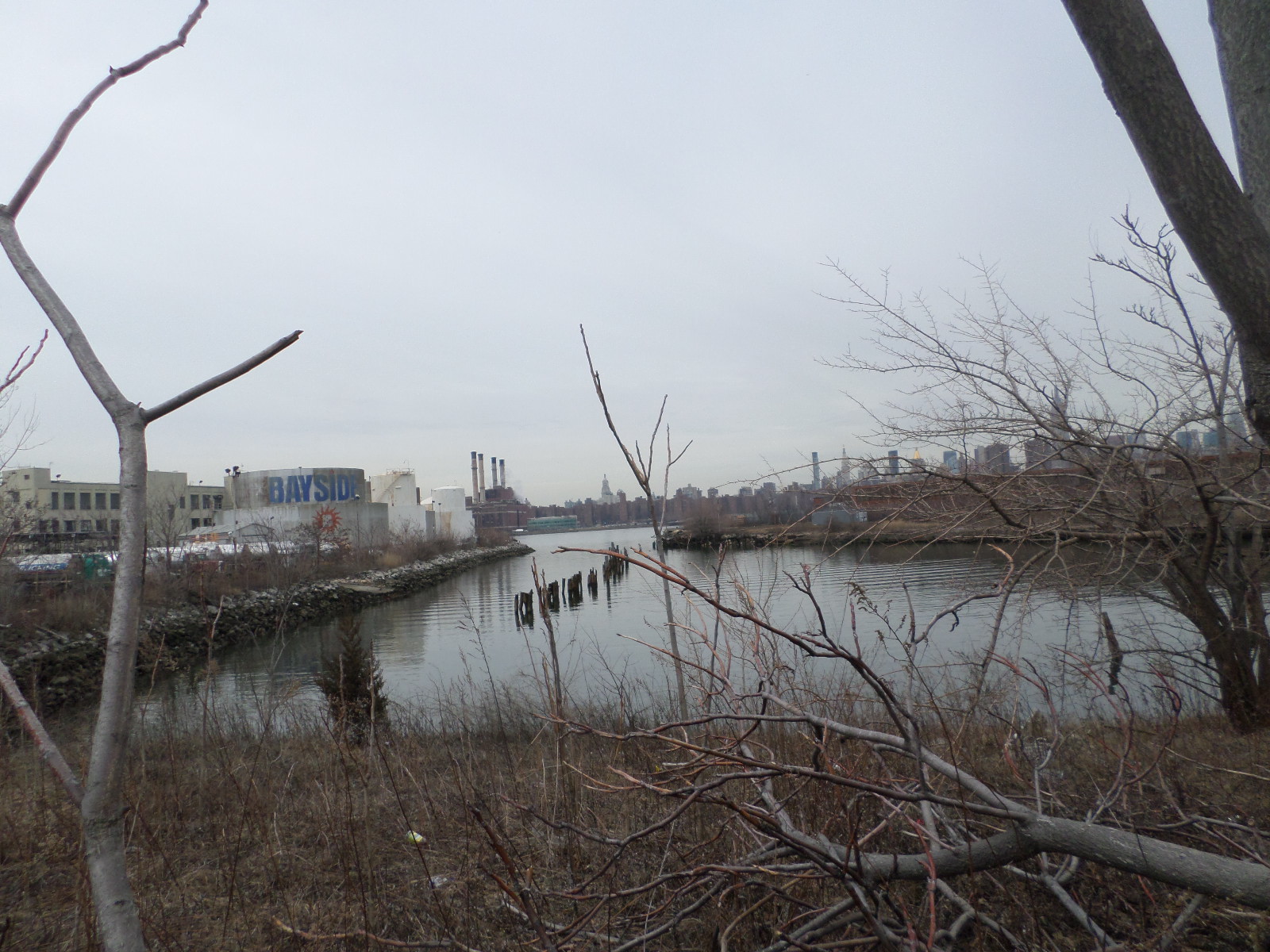New York Needs Electronic Health Records
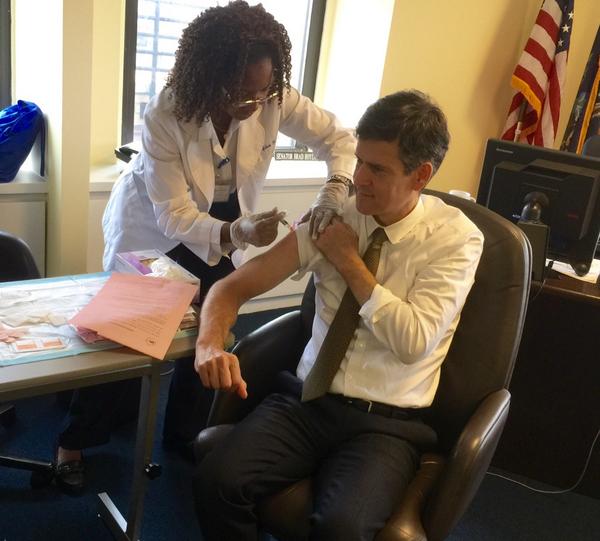
State Sen. Hoylman gets a flu shot (photo: @bradhoylman)
Teenagers aren't the only ones keeping up with the latest technology. Today, nearly three-quarters of Americans over the age of fifty are "plugged in" and regularly using the internet. As we get more connected, however, we're demanding the same of our medical care. Because many patients often have multiple doctors, it's important that all of their providers have access to their medical records.
This year, Governor Cuomo's budget again includes support for the continued development of New York's Statewide Health Information Network (SHIN-NY). This important state investment will enable patients and their doctors to seamlessly exchange electronic health records wherever they are in the state. The network is already gaining momentum: over 50,000 doctors and healthcare providers participate in SHIN-NY, and over 7 million New Yorkers have given consent to have their records shared.
SHIN-NY will be a game-changer for millions of people in New York State, especially those living with chronic conditions. Sixty percent of the American population over the age of fifty may have at least one chronic illness, whether it's heart disease, cancer, diabetes, or arthritis. In fact, many have more than one condition. For these New Yorkers, SHIN-NY will greatly simplify and improve the way medical care is delivered.
For example, it will no longer be necessary to hand-carry blood tests, x-rays, MRI scans or charts between doctors. If you're away from home and have an unexpected emergency, it means the doctor treating you will be able to access your health history, including drug allergies and pre-existing conditions, in order to provide the best possible care.
SHIN-NY will also help doctors share vital care information with other doctors, greatly improving the coordination of your care. This is critical, for example, if you see multiple doctors or have several medical conditions because doctors can make sure that the medication they prescribe doesn't conflict with your other medications or conditions.
Further, SHIN-NY will allow doctors and providers across healthcare settings to work together to address different parts of a person's illness. For example, a woman who recently had open-heart surgery and is a diabetic can be assured that her cardiologist, dietician, and primary care physician are coordinating effectively by accessing information through SHIN-NY to ensure she fully recovers from the surgery and receives proper, post-operative care, even after she's been discharged from the hospital.
Longer-term, increased care coordination will dramatically impact the cost and quality of healthcare in New York by reducing hospital re-admissions and avoiding unnecessary tests. And, this coordination will have the most profound impact on New Yorkers over the age of 50.
With budget negotiations ongoing, I urge the New York State Senate and Assembly to join Governor Cuomo in renewing their efforts to continue the development of the SHIN-NY.
***
by Carol Raphael, a board member of the New York eHealth Collaborative and former CEO, Visiting Nurse Service of New York.
***
Have an op-ed idea or submission for Gotham Gazette? E-mail editor Ben Max: This email address is being protected from spambots. You need JavaScript enabled to view it.
The 'Either/Or' of an Assembly Member's Stand on Education

Rally outside AM Rodriguez's office (photo: Alliance for Quality Education)
Last Friday, and despite a snowstorm, dozens of parents, students, and education advocates picketed in front of Assembly Member Robert Rodriguez's East Harlem office demanding that he stand up for all public school children. Many in his district are frustrated by the fact that he has turned a deaf ear to their concerns, as reflected in his wrong stands on education.
While many of the public schools in his district can no longer support co-locations, Mr. Rodríguez has pledged his support for raising the charter school cap, which will lead to additional co-locations.
In a recent column printed in this publication, Assembly Member Rodriguez tried to paint himself as fair, but his arguments proved his charter bias. While he mentions the 143,000 students attending struggling district schools, he makes no reference to the troubling disparities in student population at charter schools and the suspension rates that are ten times those in public schools. Like the Assembly Member wrote, "education isn't either/or."
In his district, for example, public district schools serve 30 percent special education students compared to only 17 percent in charters. The disparity in the children taught in self-contained special education classes is not any better – 9 percent in district schools versus only 1 percent in charters, according to data from Alliance for Quality Education.
During the picket, parents delivered an over-sized copy of a letter that the assembly member refused to sign, which not only highlights all those staggering facts about charters but that also has been signed by two dozen Democrats in the Assembly. Parents are still waiting for an answer.
In his column, he does ask for an increase in funding for children with special needs who can be in mainstream classrooms, but rather than a call for inclusion, his argument sounds more like an excuse for why charters exclude high-need student populations.
More privately-run charter schools will divert funds from our local public schools desperately in need of those resources.
Raising the charter cap will only benefit the pockets of hedge fund billionaires who are now driving Governor Andrew Cuomo's education policy - and clearly now Assembly Member Rodriguez's too. He is responding to the $20,700 he has received in campaign donations from the same group of donors who have contributed so heavily to the governor's campaigns. That's why parents and advocates have urged him to return it.
We need our elected officials to stand up for a government that works for all of our children and not the interests of the wealthy. That's a position that Assembly Member Rodriguez has yet to prove.
***
by Carlos Ruiz, East Harlem resident, public school parent, and member of New York Communities for Change
***
Have an op-ed idea or submission for Gotham Gazette? E-mail editor Ben Max: This email address is being protected from spambots. You need JavaScript enabled to view it.
Sky’s the Limit for Solar in New York
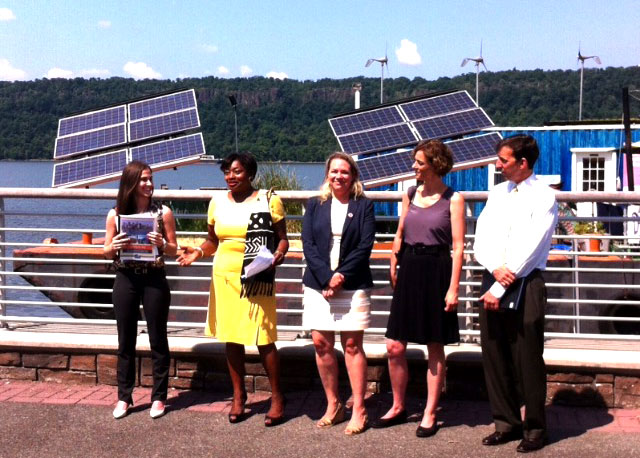
The author, far left, & others at a solar panel event
Fifteen years ago, flat-screen televisions were a rare luxury item, a smart phone was one with an address book, we kept our music on plastic discs, and video chats were a feature in Star Trek episodes. Now there's widespread use of handheld devices that enable us to listen to music, watch videos, talk, text or video-chat with friends or colleagues, while also providing immediate access to a world of information.
Times have changed, and solar power is a case in point. Fifteen years ago, solar was used by a small number of true believers. Now, because of advances in technology and growing economies of scale, solar costs 25 percent of what it cost in 2000.
Solar panels are popping up all over: on homes, businesses, places of worship, and government buildings. Just over two months ago, in his State of the Union address, President Obama summed it up when he said, "Every three weeks, we bring as much solar online as we did in all of 2008."
Here in New York, solar energy grew 63 percent per year between 2010 and 2013. That's fast enough to reach a goal of 20 percent solar in New York by 2025– a goal once thought ambitious, if not impossible, but now readily achievable.
"Star Power: the Growing Role of Solar Energy in New York," a recent report by Environment New York Research & Policy Center, shows that growth could actually slow down to 47 percent and solar energy would still provide 20 percent of our power in the next decade.
This is a critical finding at a time when state regulators are trying to transform the New York's energy efficiency and renewable energy programs through Governor Cuomo's "Reforming the Energy Vision" (REV) initiative.
Boosting solar energy power production is more urgent than ever. Scientists have never been clearer that global warming is real, happening now, and will only get worse without meaningful action. In New York, we're already feeling consequences like Hurricane Sandy and other more extreme weather.
Achieving 20 percent solar energy would cut as much carbon pollution as 3 million cars emit in a year, and put New York more than halfway to the benchmark set by the U.S. Environmental Protection Agency's Clean Power Plan, which requires cuts in power plant carbon pollution of 44 percent.
More solar isn't just good for the environment. It's also good for our economy. Solar is currently the fastest-growing industry in the country, adding 143,000 jobs nationwide in 2013. According to the latest solar jobs census from the Solar Foundation, the solar industry employed more than 7,000 people in New York last year.
Of course, 20 percent solar is just a sliver of the possible. The state is home to more than 1.9 million residential and commercial rooftops that could host solar panels, and it has enough technical potential to meet the state's energy needs 11 times over.
We've made progress. But we can't take that progress for granted. Powerful interests, including the fossil fuel industry and electric utilities are working hard to slow gains. To take solar to the next level, we'll need a strong commitment from our local, state, and national leaders. By adopting a goal of getting 20 percent of our power from the sun by 2025 and working together, we can begin to move New York and the nation toward a future where we get all of our power from pollution-free energy sources. Our quality of life and our children's future depend on it.
***
Heather Leibowitz, Esq. is the Director of Environment New York, a statewide environmental advocacy organization.
***
Have an op-ed idea or submission for Gotham Gazette? E-mail editor Ben Max: This email address is being protected from spambots. You need JavaScript enabled to view it.
Education Isn't Either/Or
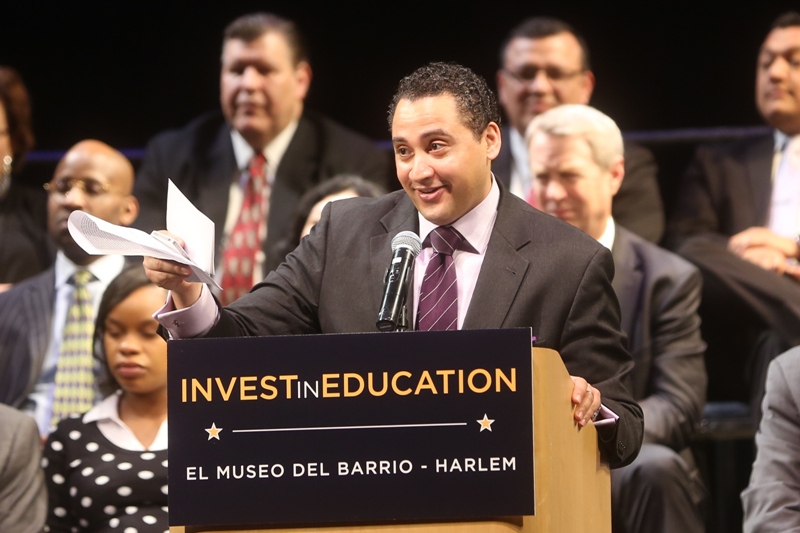
Assembly Member Rodriguez, the author (photo: investined.org)
Each year education advocates head to Albany to fight for our children, this year was no different as thousands arrived on the steps of the Capitol last week clad with signs, flyers, and banners. Yet, among all the differences, all the arguments they bring to the table, one thing is clear – our children need our help.
There are a bounty of choices for parents: public schools, charter schools, private and parochial schools; I hear the benefits of each and we feel the successes of their graduates in our community. There are a million reasons to choose one over another, but the choice is limited if they don't receive adequate funding to stay open.
There are 143,000 children, the majority of them children of color from low-income neighborhoods, stuck in failing schools that are crippled by a lack of basic resources, including equitable funding. The $1.8 billion increase in school funding put forth by Assembly Speaker Carl Heastie, myself, and my colleagues will fill the Gap Elimination Adjustment and start meeting the $4.9 billion Campaign for Fiscal Equity (CFE) commitment we so badly need to keep schools funded.
It's simple to fix this problem by allocating more money in the budget for schools through tax proposals - we already have a school system that has been hurt by property tax caps. However, dedicating a larger portion of the State's bank settlement funds towards CFE will allow us to make the needed improvements to our schools.
As we fight for what we deserve from the CFE settlement, we must also explore education reforms. Funding and improving our schools must not be an either/or conversation; we should willingly implement reasonable changes that provide the best results for our kids.
First, we must ensure adequate funding for quality pre-Kindergarten programs. Pre-K is integral in identifying and helping special needs students early in the educational process. The ability to detect special needs early will allow parents to work with teachers to identify the best course of action to ensure their child gets the help they need and can potentially eliminate their need to be enrolled in special education (SPED) to begin with.
Second, we need to reevaluate our SPED programs. African-American and Hispanic children are more than twice as likely as their white counterparts to be identified by teachers as having serious learning disabilities, and they are 1.5 times more likely to be funneled into SPED services than all other racial and ethnic groups combined.
In New York City, district schools receive an extra $2,309 to $8,609 per SPED student, and often even this is insufficient. Further, If a school graduates a student out of SPED status and provides only supplemental support, the extra school aid drops to just $500, creating a disincentive for schools to graduate students from SPED. While there are schools, both district and charter, which do serve special needs students, and serve them well, many do not. We should increase special education funding for students who can be in mainstream classrooms but need additional services, eliminating the disincentive to move students out of SPED.
Third, we need to explore what accountability looks like through fair and unbiased evaluations. Our teachers can't be portrayed as villains, they are our greatest ally in ensuring our children get the best education.
Last, where teachers and principals have been found to have committed a violent crime, been involved in misconduct involving the sexual abuse of a student, or found incompetent through a pattern of ineffective teaching, a swift suspension or removal process must be implemented to protect our children. Lengthy processes hurt our schools' abilities to educate our children and thus hold our students back.
As we work toward a budget that includes what is owed us from the CFE lawsuit, we must not ignore the areas where we can learn and enhance the opportunities we provide to our children. Our educators and communities, our teachers, our district schools, our charters, and ultimately, our students, have too much on the line to ignore the necessity for bold action, structural improvements, and needed investments to end our state's failing school crisis.
***
Assembly Member Robert Rodriguez represents East Harlem/El Barrio and the Upper East Side.
***
Have an op-ed idea or submission for Gotham Gazette? E-mail editor Ben Max: This email address is being protected from spambots. You need JavaScript enabled to view it.
New York Colleges Need the DREAM Act
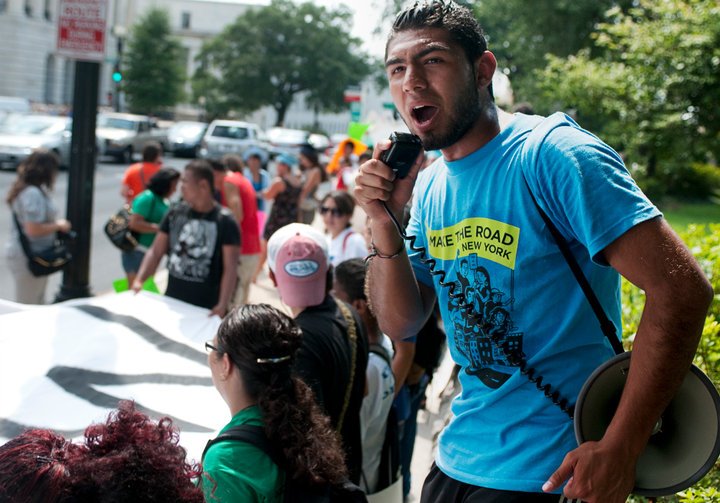
Francisco Curiel, one of the co-authors
Queens College is a special place. As one of the country's most culturally diverse campuses—we serve men and women from more than 150 countries—the college seeks to "prepare students to become leading citizens of an increasingly global society," as our mission statement notes. We pride ourselves on being accessible and offering a rigorous education. In keeping with our motto—"We learn so that we can serve"—we provide an education that will enable our graduates to better serve their communities and the needs of our beloved New York State.
We strive to make Queens College as accessible as possible to all New Yorkers who meet our high admissions criteria. But there is a major roadblock confronting many DREAMers (undocumented immigrant students). The roadblock is that, because of their status, DREAMers are ineligible for financial aid.
All of New York State's colleges and universities would benefit from the passing of the DREAM Act. Its passage would open up the state's Tuition Assistance Program (TAP) to DREAMers who meet TAP's eligibility criteria. We would also be better able to achieve our goal of educating all New Yorkers and putting them on the path to high-skilled employment.
There are three main reasons why the DREAM Act should be passed immediately. First, the DREAM Act would open the doors of educational opportunity to thousands of students who otherwise would be unable to earn a college degree. This would be life changing for these young people and their families. The DREAM Act would also benefit immigrant youth who already are on campus. One of us (Mr. Curiel) is an undocumented youth and a Queens College student who maintains good grades and participates in campus life. However, he has no access to state-funded financial aid, which means significant financial strain on his family, as it does on thousands of other New York families.
Second, the DREAM Act could further advance academic excellence on our campuses. Numerous studies show that all students benefit when they are part of a diverse student body. Queens College students benefit from the rich exchange of ideas and experience that occurs in our classrooms, cafeterias, and common spaces among students from different backgrounds—whether those be national origin, race, culture, ethnicity, or sexual orientation. Having more DREAMers on our campuses would further invigorate classroom discussions and campus life, benefiting DREAMers and non-DREAMers alike. It could also help DREAMers feel more comfortable on campus by eliminating the arbitrary barrier that immigration status can sometimes impose.
And third, the DREAM Act would enable us to fulfill our mission of educating all New Yorkers and developing a skilled workforce grounded in a liberal arts and science education. In today's global economy, it is essential that we develop an educated workforce to keep New York State ahead of its competition. To do this, we must ensure that every qualified young person who wants to go to college can do so.
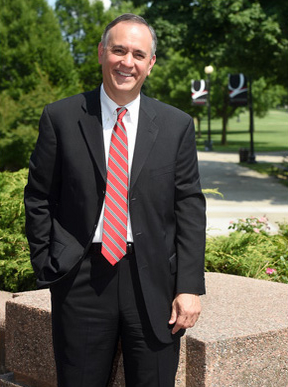
Queens College President Matos Rodriguez
A report by the Office of the State Comptroller (OSC) found in 2014 that "the short-term costs of extending financial assistance to undocumented students would be outweighed by the long-term economic benefits." Having more DREAMers in our colleges would significantly increase the ranks of high-skilled workers contributing to our state economy. It would also strengthen our state's tax base, as the OSC found that "a person earning a bachelor's degree would pay more than $60,000 in additional State taxes, compared with a maximum TAP award of $20,000."
In short, the DREAM Act makes sense on three fronts: expanding educational access to New York's youth, enriching our campus life, and benefiting our state economically and socially.
The only challenge now is the willingness to act. By passing the DREAM Act, New York State would be standing up for its talented immigrant youth. It also would be standing up for the continued excellence and vibrancy of our higher education institutions. These are goals we can all support.
****
by Félix V. Matos Rodríguez and Francisco Curiel. Matos Rodríguez is the President of Queens College; Curiel is a Queens College student and a Youth Power Project member of Make the Road New York.
***
Have an op-ed idea or submission for Gotham Gazette? E-mail editor Ben Max: This email address is being protected from spambots. You need JavaScript enabled to view it.
Legitimacy of City Land Use Process at Stake in Brooklyn Park Problem
The Bushwick Inlet (photo: Janos Marton)
I think there is zero chance of developers walking away from this waterfront. Look at this view! This is the best view in New York City, maybe in the whole world. You've got the entire Manhattan skyline right in front of you. - Council Member David Yassky (Williamsburg/Greenpoint), 2005
In Williamsburg and Greenpoint, luxury condos have been popping up like mushrooms after the rain. Yet ten years after North Brooklyn was promised a 28-acre park on the East River, that park's prospects seem as remote as ever, in danger of slipping away for good. Recently, neighborhood groups have revived the clamor for Bushwick Inlet Park. At stake is not only greenspace for a community that desperately needs it, but the fundamental legitimacy of the city's land use policy. In 2005, Williamsburg/Greenpoint underwent an enormous rezoning, allowing today's luxury buildings. That rezoning came with a promise from the city, and if the city cannot deliver Bushwick Inlet Park, New Yorkers should not trust the city when it comes to rezone their neighborhoods.
Some New Yorkers think of Williamsburg as a gentrified monolith, but it is full of working class communities that have been there for decades: Polish and Italian on the North Side, Puerto-Rican, Dominican and Hasidic on the South Side. These cultural groups have clashed a great deal over the years, but little has brought them together like waterfront development, long blocked off to all of them by heavy industry.
Activists began organizing around waterfront development in the mid 90s, collaborating on Brooklyn Community Board 1's comprehensive 197-A Plan for the waterfront. A 197-A Plan is the most powerful (though still non-binding) tool under the City Charter for neighborhoods to chart their own long-term development, and this plan recommended large open spaces, public access to the waterfront, mixed use development along Kent Avenue, and a strong commitment to affordable housing. The plan was approved by the City Planning Commission in 2001 and City Council in 2002.
Yet in 2005, when Mayor Bloomberg went all in on his Olympic bid and needed the Williamsburg waterfront for beach volleyball, his administration tossed the 197-A plan in a recycling bin and put forward a whole new rezoning vision for the waterfront rooted in luxury development. The community fought that proposal with everything they had. Elected officials opposed it. People rallied at City Hall. Guerilla activists in costume raised awareness. Articles were written. Forums were held. Multiethnic alliances were forged. TV on the Radio played a show in support of neighborhood activists! You couldn't have asked for better democracy in action.
When modifications were made to the rezoning proposal, some remained upset, but others admitted that the affordable housing, public park and economic development opportunities made the deal a fair one. City Council Deputy Leader Brad Lander, then with the Pratt Center, raved, "The communities of Williamsburg and Greenpoint win because today there is a guarantee of new and permanently affordable housing, instead of a virtual guarantee that new development would price residents out of their homes."
The revised 2005 rezoning, which featured 54 acres of new parkland, including a 28-acre park at the Bushwick Inlet, passed overwhelmingly. To help visualize the promised park, it would be 80% the size of McCarren Park, flank the Bushwick Inlet, and include a beach and boating. North Brooklyn is currently 5% parkland, a third of the city average, is nowhere near a major park, and has one of the lowest open space ratios in the city. If luxury condos were going to change the neighborhood forever, at least the neighborhood would be getting something it needed in return.
The 2005 deal wasn't without its critics, specifically because of concerns that promises to the public wouldn't be delivered. Kimberly Miller from the Municipal Arts Society observed that Jersey City's recent waterfront rezoning had similarly made promises based on private development that never came to fruition. The legendary Jane Jacobs predicted "with utter confidence" that the 2005 plan "will maybe enrich a few heedless and ignorant developers, but at the cost of an ugly and intractable mistake." (Like one developer who built 4,000 waterfront condos after contributing heavily to NY2012, the Bloomberg committee behind NYC's attempt to win the Olympics.)
There's a lot more to this story:
visit Janos.NYC to continue reading
***
by Janos Marton for Gotham Gazette and Janos.NYC
@janosmarton
The Challenge of Cultural Change on Rikers Island
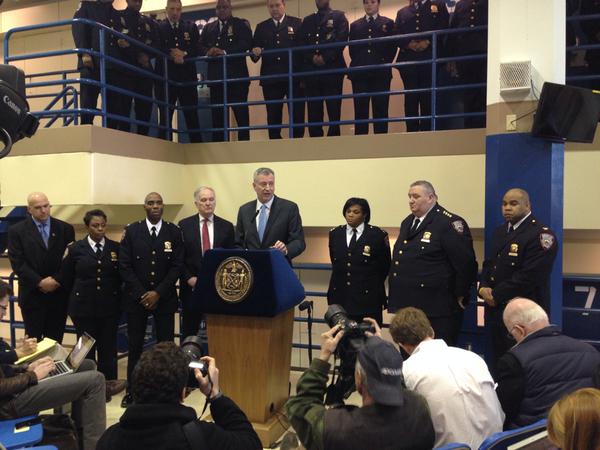
Mayor de Blasio at Rikers (photo: @MonicaCKlein)
After three years of volunteer service, I recently stepped down from the New York City Board of Correction, which is responsible for ensuring that all city jails, including Rikers Island, meet certain minimum standards regulating the care of inmates.
It wasn't the happiest experience I've ever had. While I was on the Board of Correction, Rikers Island became a topic of intense local and national concern. Thanks in no small part to intrepid reporting by Graham Rayman, Jake Pearson, Michael Winerip, Michael Schwirtz and others, there is now widespread agreement that Rikers Island requires significant reform.
One of the statistics we monitored at the Board of Correction is the use of force by correction officers. While I served on the Board, there were a number of horrific incidents where inmates were injured. In several cases, inmates died. Even though I have worked in criminal justice for more than 20 years, I found these incidents shocking and appalling.
On my tours of Rikers Island, I had the chance to meet numerous correction officers. I always sized them up, looking for signs of cruelty. To be honest, what I found more often were signs of compassion. Many (but by no means all) of the correction officers I met expressed real pride in their jobs and real concern for the inmates in their charge. Even in the most horrible of settings – and make no mistake, the jails on Rikers Island are horrible places to be – these officers were capable of small acts of kindness and understanding.
How do we square this reality with The New York Times reports of "medieval levels of violence" meted out with "startling ferocity" by guards at Rikers? Or to ask the question another way, how do we encourage more kindness and less brutality by correction officers?
I have come to the conclusion that the answer is not necessarily more rules or more scrutiny.
In truth, there is no shortage of oversight of Rikers. In addition to the New York City Board of Correction, there is the New York State Commission of Correction, the New York City Council, the media, the courts, and the U.S. Attorney's Office. And this doesn't even begin to list the advocacy groups that keep tabs on what happens on the Island.
Despite all of this, a recent Times headline reported a hard truth: "Even as Many Eyes Watch, Brutality at Rikers Island Persists."
There is an old business adage that "culture eats strategy for breakfast." I fear that the current approach to change on Rikers Island leaves the "deep-seated culture of violence" identified by U.S. Attorney Preet Bharara mostly untouched.
Any effort to change the culture on Rikers must reckon with the deteriorating physical plant, which is beyond antiquated. Even with the reductions in volume that we have seen over the past 20 years, there are still too many people on Rikers – the daily headcount is typically around 10,000 inmates. It is exceedingly difficult to manage this many people humanely in facilities that are falling apart. As the MacArthur Foundation and others have argued, we must explore ways to reduce the number of people in jail, particularly those who are detained pre-trial. And, as former NYC Correction Commissioner Marty Horn has said, we should be looking at options to close Rikers Island and create smaller, county-based facilities with modern amenities (like air conditioning).
Even as we attempt to reduce head counts and improve the physical environment, we should also be having an honest conversation about discretion. A generation ago in the seminal book Street-Level Bureaucracy, Michael Lipsky pointed out that the exercise of discretion is a critical dimension of the daily life of frontline government workers, be they police officers, social workers, teachers, or correction officers.
While we can and should develop baseline standards for correction officers, the truth is that it is impossible to create protocols for every situation that they will experience on the job – no matter how hard we try, there will always be room for officers to exercise discretion, for good or for ill.
Given this reality, we must work harder to create a clearer sense of mission at the Department of Correction. Rules cannot do this. As professor Mark Kleiman (channeling the spirit of James Q. Wilson) has written: "Organizations prize autonomy...Deprivation of autonomy tends to worsen morale and thus performance. The impulse to over-regulate the public sector is a destructive impulse."
In visiting Rikers Island, I never once felt I was in a place of "correction," where the dominant philosophy was one of rehabilitation. To change this will require a significant investment of energy, money, and time. This means taking unglamourous steps that may not yield dividends for years to come, including increasing the salaries of corrections officers, changing the union dynamic, raising hiring standards, investing in research to help promote a learning culture, and giving correction officers a meaningful voice in reform plans as a means of increasing their buy-in.
While many demand immediate change, the reality is that Mayor de Blasio inherited problems on Rikers Island that were decades in the making. We should be realistic about what his administration can accomplish in the short term – and encourage the formulation of a long-term plan that truly changes the culture of the institution.
***
Greg Berman is the Director of the Center for Court Innovation and author of Reducing Crime, Reducing Incarceration: Essays on Criminal Justice Innovation (Quid Pro Books).
***
Have an op-ed idea or submission for Gotham Gazette? E-mail editor Ben Max: This email address is being protected from spambots. You need JavaScript enabled to view it.
Citywide Rezoning Plan Would Benefit Developers, Hurt Neighborhoods
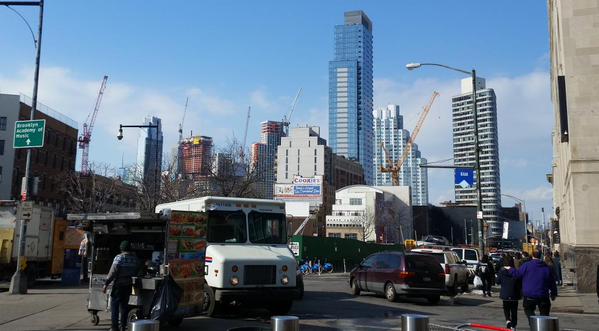
Cranes over Brooklyn (photo: Michael Flynn)
A citywide rezoning proposal quietly released by the de Blasio administration last month has begun the public review process. 'Zoning for Quality and Affordability' sounds like mom and apple pie, as it purports to make new housing less costly and meet higher standards. But a closer examination calls these premises into question. Big real estate, not average New Yorkers, would be the main beneficiary of some of the plan's key provisions, and its cost would be the undoing of neighborhood zoning protections years in the making.
The proposal is quite broad in its scope. But a central element is raising the allowable height of new development in "contextual zoning districts" -- areas where specific height limits and streetwall requirements help ensure that new buildings fit their context. These rules are meant to keep much of the "sore thumb" development we see around the city from cropping up in residential neighborhoods with strongly defined character, from the Lower East Side to Harlem, Crown Heights to Jackson Heights, the Village to Sunset Park.
Many of these height limits took years of effort by local communities to secure, and often involved compromises and trade-offs with the city and real estate interests to attain modest controls.
Now those rules would be upended, with the height caps lifted by as much as 20 to 30 percent, across the board.
As the plan's title implies, the rationale for these proposed changes are improvements in "quality and affordability," but neither seems likely to result from the current plan.
First, in many cases the proposed height limit increases would apply to purely market-rate housing. For example, in one of the more common contextual zoning districts, developers would automatically get to build about 20 percent taller than currently allowed for new luxury development. In the fraction of those districts where developers get more square feet if they reserve 20 percent of the units for affordable housing, there would be an additional 10 percent bump in the allowable height for such construction.
But even the height increase for developments that include 20 percent affordable housing raises serious questions. In existing contextual zoning districts such as the East Village, we have seen affordable housing included in some new developments built with the current, hard fought-for height limits, though not in every one. The City says higher height limits will mean more affordable units built, but the mixed results in places like the East Village don't offer any clear indication that this is so.
Including affordable units is currently optional in these zones, and this plan would not change that. It seems that the optional nature of the program, along with a variety of other factors, have a much bigger impact upon the number of affordable units built, rather than the height limits.
But for argument's sake, let's say raising height limits in contextual zones would increase participation in the 20 percent affordable housing program. Advocates for this approach point to the two areas of the city where significant numbers of affordable units have been produced through this program, West Chelsea/Hudson Yards and Williamsburg/Greenpoint. They have much looser height restrictions on new development and a significant number of their tidal wave of new, luxury developments include 20 percent affordable housing.
At the same time, though, in the ten years since that program has been implemented in those neighborhoods, they have seen a nearly unprecedented rise in rents and housing prices. In other words, in the two cases where this program has been most successful – where we have seen the highest rates of developers choosing to include 20 percent affordable housing in their new developments – we have also seen perhaps the most dramatic overall loss of affordability.
Is this the future we want? And is this not the inevitable result of tying the production of every new affordable apartment to four market-rate, super-luxury ones, which is enshrined in this proposal?
The other rationales for the increased height limits in the plan are equally dubious. The City claims current contextual zoning rules result in flat, boxy buildings; undesirable street-level ground floor apartments; and substandard floor-to-ceiling heights that discourage development. By lifting the overall height of buildings and loosening the contextual zones' streetwall requirements, the City claims more attractive and livable buildings that are cheaper to construct will result.
In fact, while some new buildings in contextual zones are mediocre in design, some are actually quite appealing – it really depends upon the architect and developer. But non-contextual zones, with no height limits or streetwall requirements, routinely see some of the most uninspiring, cringeworthy new designs in the city, poking a big hole in the "less restrictions equals better design" theory.
And as for the notion that current height limits are discouraging development or making for substandard apartments, one need only look at the flood of new construction in contextual zones from Bedford-Stuyvesant to Astoria, Park Slope to the Upper East Side. People are lining up to live there, and developers are making a hefty profit.
But perhaps not as hefty as they would like. Fewer restrictions on height, allowing grander floor-to-ceiling heights and apartments with more commanding views, would fetch developers even higher prices. But it certainly would not make these new apartments more affordable. And neighborhoods would pay the price with less light, air, and sky, and a loss of the character and scale they fought so hard to maintain.
The main beneficiaries of these aspects of the 'Zoning for Quality and Affordability' plan appear to be real estate interests, not those who care about quality design or affordable housing. It's likely no coincidence that these proposed changes are ones that deep-pocketed developers have sought for years. Now, wrapped in claims about quality and affordability, they finally have a chance to get them.
The mayor's 'Zoning for Quality and Affordability' plan is not without good points, and its stated goals are worthy of support. But substantial modifications are needed to protect neighborhood character and benefit average New Yorkers before it can live up to its lofty premise, and before it should be considered for adoption.
***
Andrew Berman is the Executive Director of the Greenwich Village Society for Historic Preservation
****
Have an op-ed idea or submission for Gotham Gazette? E-mail editor Ben Max: This email address is being protected from spambots. You need JavaScript enabled to view it.
Separating Fact from Fiction on the DREAM Act
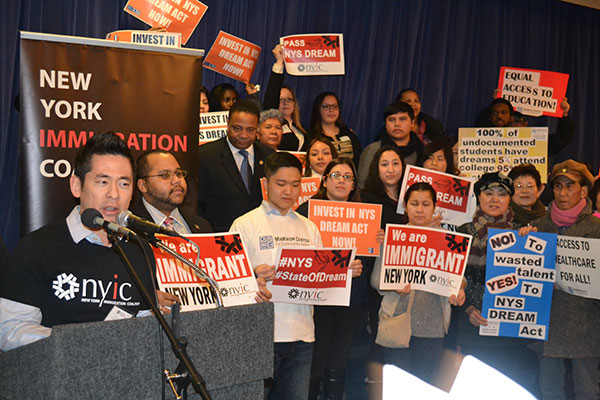
The author at a rally for the DREAM Act
The gridlocked Congress' failure to produce needed, overdue immigration reform prompted several states to create their own versions of the proposed federal DREAM Act, which would provide publicly financed college tuition aid to undocumented immigrants.
Texas, a red state; California, a blue state; and New Mexico, a purple state; each has adopted its own version of the DREAM Act.
In New York, the DREAM Act enjoys the support of editorial boards as varied in their opinions, politics, and geographical concerns as Newsday, the New York Post, Rochester Democrat and Chronicle, the New York Times, the Albany Times Union, and the New York Daily News.
So why did the New York DREAM Act go down in defeat—narrowly—in the Legislature last year? Mostly because of fear and anger stirred up by opponents through the spread of misinformation.
If New York is to enact the DREAM Act this year and make the commonsense investment in its workforce and future that editorial boards, elected officials, and New Yorkers across the state are calling for, we need to separate the fact from the fiction.
Fiction: The DREAM Act will take money away from students who were born in this country and give it to those who were not.
Fact: New York's Tuition Assistance Program (TAP) is an entitlement program. Each and every student who meets the TAP income eligibility and other requirements is entitled to financial aid—no matter what. The additional cost of providing TAP dollars to Dreamers is estimated to range between $17 million and $27 million, about a .00018% increase in the state budget.
Fiction: The DREAM Act will reward people who broke the law.
Fact: Punishing young people for something their parents did is not the American way. And let's not lose sight of the fact that what the parents of Dreamers are guilty of is wanting a better life for their children, like generations before them and generations to come.
Fiction: The DREAM Act doles out tax dollars to people who themselves don't pay taxes.
Fact: According to a study by the Institute on Taxation and Economic Policy, undocumented immigrants contributed an estimated $744,276,000 New York State taxes in 2010. At the federal level, the Social Security Administration each year keeps $6 billion to $7 billion in social security contributions from W-2s that cannot be matched with a correct social security number. The vast majority of that money comes from undocumented immigrants who are forbidden by law to access many of the most basic government services which they help fund.
And the Fiscal Policy Institute has calculated that bachelor's degree holders pay an additional $3,900 in annual state taxes, meaning that TAP funding for the undocumented would more than pay for itself within six years.
In other words, making college more affordable for all is a smart investment in workforce development and our state's future. The more educated our workforce, the better it is for our economy - and Dreamers will most certainly be part of our workforce. They don't know any country other than the United States. Their futures are here.
Let's follow the bipartisan example of the five states that have already passed a DREAM Act. Let's come together in New York and make the DREAM Act a reality.
***
by Steven Choi is Executive Director of New York Immigration Coalition (on Twitter @stevechoinyic & @thenyic).
***
Have an op-ed idea or submission for Gotham Gazette? E-mail editor Ben Max: This email address is being protected from spambots. You need JavaScript enabled to view it.
Our Time in Selma

Council Member Dan Garodnick, in Selma
Last weekend, my wife Zoe and I had the privilege of going to Alabama to trace some steps of the foot soldiers of the Civil Rights Movement as part of the jubilee celebration of the 1965 march from Selma to Montgomery. We were honored to pay respect to those who gave so much of themselves in pursuit of justice and who changed American history in the process. We immersed ourselves in that history as part of a group organized by the Faith and Politics Institute, and came away with an even deeper resolve to further their work.
We sat in the 16th Street Baptist Church in Birmingham, where a bomb exploded over 50 years ago, tragically stealing the lives of four young black girls, their futures taken from them while they were changing into their choir robes.
We visited Brown Chapel A.M.E. Church in Selma, where ordinary Americans gathered to learn the tactics of nonviolence, and steeled themselves for the unknown as they endeavored to march 55 miles to Montgomery to deliver a clear message to the Alabama Governor, and ultimately to the world.
And we went to the Edmund Pettus Bridge, the site of Bloody Sunday -- where so many of them were brutally attacked by an angry mob of police -- precisely a half-century ago.
We heard Congressman John Lewis, leader of the first march in Selma, describe being beaten unconscious on that bridge as he and his compatriots attempted to march quietly, two-by-two in support of their fundamental rights.
He wasn't doing it to be a hero. He was doing it because of a deeply held belief in the equality of man, and with his faith that God would protect him from harm. Indeed, while he might have anticipated a night in jail - and had stocked his backpack with an apple, toothbrush and book for that eventuality - he didn't actually expect the march to result in violence, which it did, at the hands of billy clubs, horse hooves, and tear gas. He does not remember how he got off the bridge.
We admired his bravery in moving forward, as the police in Selma had put out a call to a mob of young white men to serve as "deputies" to help them stop this march from proceeding.
We heard him tell the story about the man who visited his congressional office in 2009, who had assaulted him years earlier, and asked for his forgiveness. Without an ounce of bitterness or regret, John Lewis forgave him and "called him my brother."
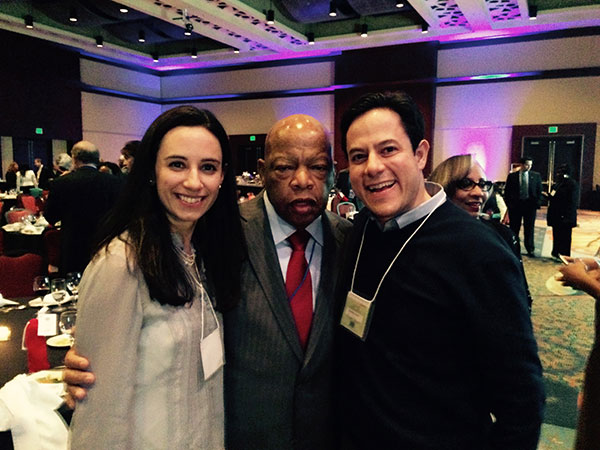
Council Member Garodnick with his wife, Zoe, and Rep. John Lewis
Among other giants from the movement, we spent time with Juanita Abernathy, the widow of Ralph Abernathy, who never missed a march.
We heard from the daughter of Viola Liuzzo, a mother of five from Detroit who heeded Dr. Martin Luther King's call to come to Selma, and who was murdered when her car was run off the road by the Ku Klux Klan. When asked why her mother went to Selma, she responded: "The real question is: Why didn't everyone go to Selma?"
And of course, we were moved to see John Lewis and President Barack Obama embrace at the foot of the Edmund Pettus Bridge. The president, whose very presence next to that bridge spoke volumes, captured the spirit of America when he referred to the courage of the foot soldiers, and asked: "What could be more American than what happened in this place?" He added: "We were born of change."
The most important takeaway for me: while times have changed significantly, the work of Selma is not complete. There is so much more to do.
On police-community relations, an issue that animated much of this past year, President Obama reminded us that the citizens of Ferguson, New York, and Cleveland "just want the same thing young people here marched for – the protection of the law." At the same time, he cautioned against marginalizing our police, as they are "members of the very communities they risk their lives to protect." This conversation will appropriately continue in New York, and all across this country, and in the tradition of Dr. King, we must do so with peace and civility in our hearts.
Significantly, our voting rights themselves are under attack. The Supreme Court recently struck down key portions of the Voting Rights Act, which gave the federal government the chance to "pre-clear" voting rules in areas with historic discrimination. At the same time, states have been enacting laws designed to make it even tougher for people to vote. All of this in a country that already has among the lowest voting rates among free nations. Those facts are beyond disappointing; they are actually disrespectful to those who gave so much to solidify basic rights for all Americans.
Unfortunately, Congress has not yet acted to fix what the Court has done.
The Voting Rights Act was, as President Obama said, a "crowning achievement of our democracy" and it is now "subject to partisan rancor." That cannot be. Re-activating key portions of the Voting Rights Act is the right way to honor those brave men and women who marched in 1965, and Congress should act without delay. If you agree, you can add your voice here.
And of course, right here in New York, we need to lead on ballot access issues. We should take steps to allow for early voting and same-day registration, as well as no-excuse absentee voting and instant runoffs - all ways to make it easier for people to participate in the electoral process. But that alone won't solve our voting issues. People still need to see a reason to come out and cast a ballot. In our last statewide election in New York, a pathetic 28.8 percent of eligible voters turned out to the polls. Scandal, negative campaigning, and general frustration are contributing factors – and we need to turn the ship around.
The visit to Alabama was inspiring and humbling at the same time. We must honor the foot soldiers of the Civil Rights Movement by giving people a reason to participate, and by defending and strengthening the rights that they fought so hard to achieve.
***
Dan Garodnick is a member of the New York City Council, representing the fourth district, in Manhattan.
***
Have an op-ed idea or submission for Gotham Gazette? E-mail editor Ben Max: This email address is being protected from spambots. You need JavaScript enabled to view it.
